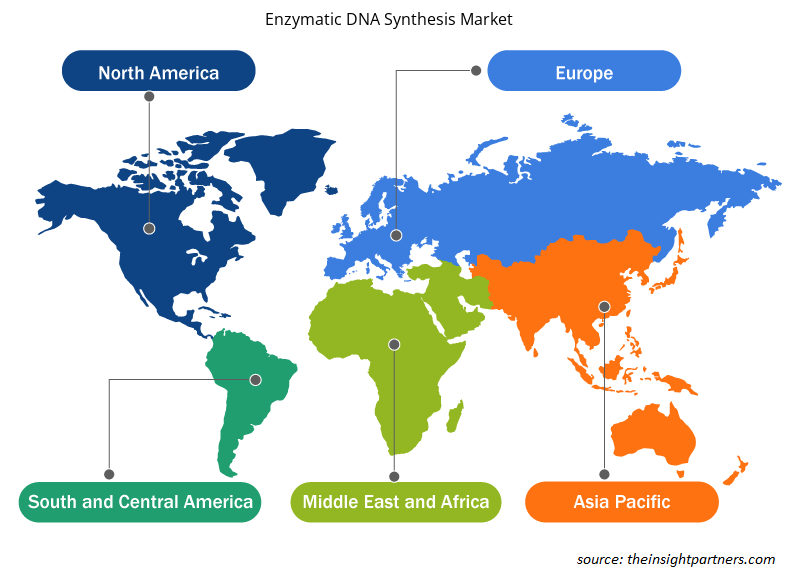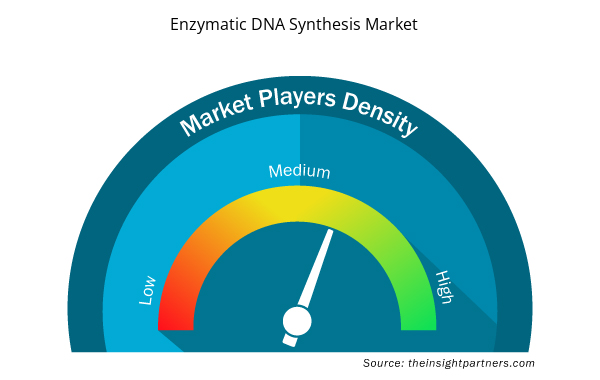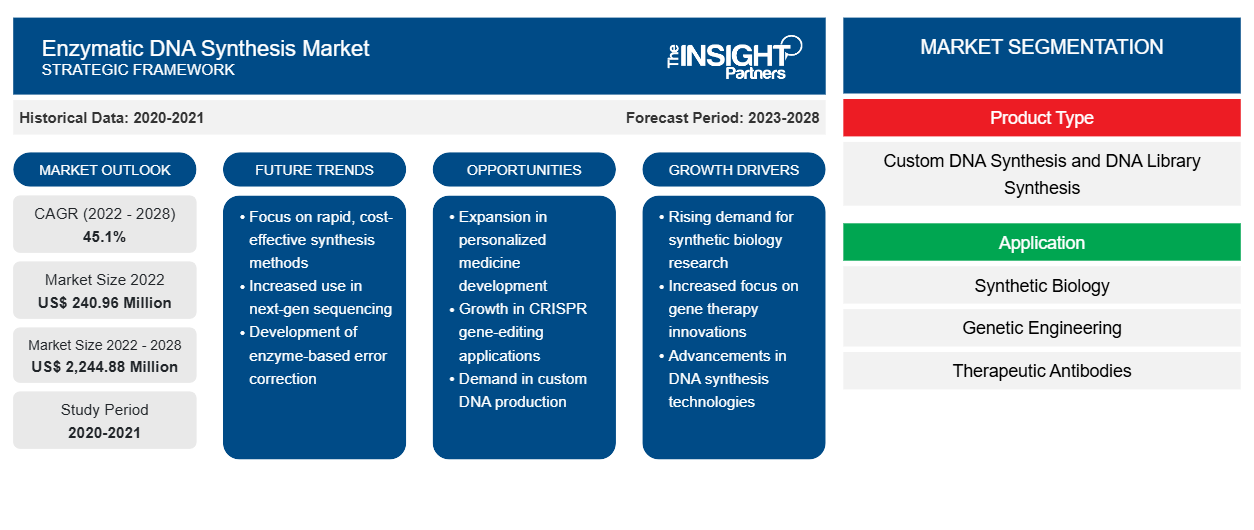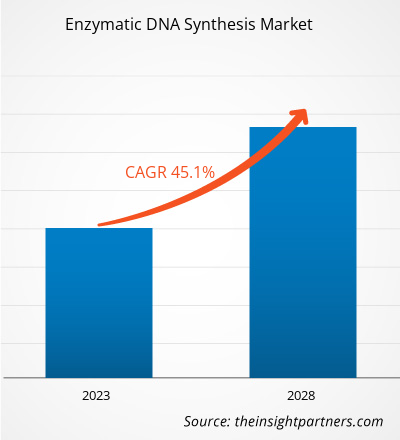[調査レポート] 酵素DNA合成市場は、2022年の2億4,096万米ドルから2028年には22億4,488万米ドルに成長すると予想されており、2022年から2028年にかけて45.1%のCAGRを記録すると予測されています。
酵素による DNA 合成は、合成生物学、遺伝子工学、治療用抗体の生産、ワクチンの設計、その他の高度な生物学的手順に役立つ、確立された DNA 合成技術です。また、DNA ライブラリの維持やカスタム DNA 分子の合成にも役立つことが証明されています。
酵素DNA合成市場の洞察
遺伝性疾患の罹患率の上昇が酵素DNA合成市場の成長を促進
ダウン症候群、自閉症スペクトラム障害、がん、糖尿病、嚢胞性線維症、鎌状赤血球貧血は、よく知られている遺伝性疾患の一部です。Global Genesによると、10,000を超えるさまざまな遺伝性疾患と希少疾患が特定されており、約4億人が希少疾患に苦しんでいます。遺伝性疾患の中には、出生時に症状を引き起こすものもあれば、時間の経過とともに発症するものもあります。遺伝性疾患の世界的な負担は増加しているようです。米国を拠点とする医療機関である国立生物工学情報センター(NCBI)によると、2021年11月の時点で、小児患者の9.4%に遺伝性疾患が確認され、44.7%が重篤な新生児でした。さらに、米国では1,317万人の患者が固有の遺伝性疾患に苦しんでいます。米国疾病管理予防センター(CDC)の2022年のレポートによると、鎌状赤血球症は約10万人のアメリカ人に影響を与え、アフリカ系アメリカ人の出生356人に1人の割合で発生します。嚢胞性線維症は世界中でよく見られる遺伝病で、米国では約 30,000 人が罹患しており、毎年約 1,000 件の新規症例が治療されています。酵素 DNA 合成は、合成生物学、遺伝子工学、治療用抗体研究で役立つ確立された DNA 合成技術です。酵素アッセイと組み合わせることで、DNA 合成はより大きな診断の可能性を示します。この方法は、リスクのある人々に関する重要な情報を提供し、病気の診断と投薬に関する重要な決定を下すのに役立ちます。したがって、世界中で遺伝性疾患の罹患率が上昇するにつれて、人々はこれらの遺伝的欠陥を早期に検出する必要性をより意識するようになり、それが酵素 DNA 合成市場の成長を促進しています。
要件に合わせてレポートをカスタマイズする
このレポートの一部、国レベルの分析、Excelデータパックなど、あらゆるレポートを無料でカスタマイズできます。また、スタートアップや大学向けのお得なオファーや割引もご利用いただけます。
- このレポートの主要な市場動向を入手してください。この無料サンプルには、市場動向から見積もりや予測に至るまでのデータ分析が含まれます。
高コストと複雑な手順が酵素DNA合成市場の成長を阻害
酵素による DNA 合成技術はまだ十分に成熟しておらず、広く普及させるにはさらなる最適化が必要です。そのほとんどは、生物系で DNA 配列に新しい塩基を追加するために使用される天然酵素の末端デオキシヌクレオチド転移酵素 (TdT) に基づいています。TdT ベースの方法は、有害廃棄物の発生を回避するため、化学的手順よりも改善されています。ただし、この酵素はコストが高く、精度が低いため、in vitro DNA 合成では使用できません。TdT 酵素は許容範囲が広く、間違った塩基を必要以上に頻繁に追加します。その結果、TdT ベースのオリゴにはより多くの配列エラーがあり、合成後の品質管理手順が同等またはそれ以上必要になる可能性があり、合成プロセスの時間とコストが増加します。この酵素を使用する場合、科学者はターゲット配列を構築するためにさらに多くの試薬を追加する必要があり、これにより合成プロセス全体のコストがさらに増加します。TdT を使用して得られた合成 DNA の塩基あたりのコストは、従来の方法で合成された遺伝物質よりもはるかに高くなります。したがって、コストが高く手順が複雑なため、酵素 DNA 合成市場の成長は制限されます。
製品タイプに基づく洞察
製品タイプに基づいて、酵素DNA合成市場はカスタムDNA合成とDNAライブラリ合成に分類されます。DNAライブラリ合成セグメントは2021年に最大の市場シェアを占めました。さらに、カスタムDNA合成セグメントは予測期間(2022〜2028年)中に最高のCAGRを記録すると予想されます。
アプリケーションベースの洞察
用途別に見ると、酵素DNA合成市場は、合成生物学、 遺伝子工学、治療用抗体、ワクチン設計、その他の用途に分類されます。合成生物学セグメントは、2021年に市場で最大のシェアを占めました。治療用抗体用途の酵素DNA合成市場は、予測期間中に最高のCAGRで成長すると予想されます。
エンドユーザーベースの洞察
エンドユーザーに基づいて、酵素DNA合成市場は、学術研究機関、バイオテクノロジーおよび製薬会社、診断研究所、その他に分類されます。バイオテクノロジーおよび製薬会社セグメントは、2021年に市場で最大のシェアを占めました。学術研究機関セグメントは、予測期間(2022〜2028年)中に市場で最も高いCAGRを記録すると予想されます。
酵素DNA合成市場の地域別洞察
予測期間を通じて酵素 DNA 合成市場に影響を与える地域的な傾向と要因は、Insight Partners のアナリストによって徹底的に説明されています。このセクションでは、北米、ヨーロッパ、アジア太平洋、中東、アフリカ、南米、中米にわたる酵素 DNA 合成市場のセグメントと地理についても説明します。

- 酵素DNA合成市場の地域別データを入手
酵素DNA合成市場レポートの範囲
| レポート属性 | 詳細 |
|---|---|
| 2022年の市場規模 | 2億4,096万米ドル |
| 2028年までの市場規模 | 22億4,488万米ドル |
| 世界のCAGR(2022年 - 2028年) | 45.1% |
| 履歴データ | 2020-2021 |
| 予測期間 | 2023-2028 |
| 対象セグメント | 製品タイプ別
|
| 対象地域と国 | 北米
|
| 市場リーダーと主要企業プロフィール |
|
酵素DNA合成市場のプレーヤー密度:ビジネスダイナミクスへの影響を理解する
酵素 DNA 合成市場は、消費者の嗜好の変化、技術の進歩、製品の利点に対する認識の高まりなどの要因により、エンドユーザーの需要が高まり、急速に成長しています。需要が高まるにつれて、企業は提供を拡大し、消費者のニーズを満たすために革新し、新たなトレンドを活用し、市場の成長をさらに促進しています。
市場プレーヤー密度とは、特定の市場または業界内で活動している企業または会社の分布を指します。これは、特定の市場スペースに、その市場規模または総市場価値に対してどれだけの競合相手 (市場プレーヤー) が存在するかを示します。
酵素 DNA 合成市場で事業を展開している主要企業は次のとおりです。
- テレシスバイオ株式会社
- エボネティクス
- アンサバイオテクノロジーズ株式会社
- カメラバイオ
- ジェンスクリプトバイオテック株式会社
免責事項:上記の企業は、特定の順序でランク付けされていません。

- 酵素DNA合成市場のトップキープレーヤーの概要を入手
テクノロジーに基づく洞察
技術に基づいて、酵素DNA合成市場はSOLA、CRISPR、PCR、その他に分類されます。PCRセグメントは2021年に最大のシェアを占め、予測期間中も同様の傾向が続くと予想されます。一方、CRISPRセグメントは予測期間中に最高のCAGRを記録すると予想されます。
酵素 DNA 合成市場の企業でよく採用される戦略は、合併と買収です。主要な市場プレーヤーによる最近の動向をいくつか以下に示します。
- 2022年4月、ジェンスクリプトは毎年開催されるBuilt With Biology世界会議で、業界初となるDNA合成用最高スループット半導体チップを発表しました。ジェンスクリプト独自の小型半導体チップ技術を使用して開発されたこの高密度DNA合成チップは、840万個のユニークオリゴを同時に合成することができます。
- 2022年4月、Evonetix Ltdは、DNA合成のための独自の熱制御技術と、欧州でのシリコンチップの設計および製造に関して特許EP3551331B1を取得しました。この特許は、EvonetixのIPポートフォリオの拡張に加えて、ベンチトップDNA合成プラットフォームを開発するという同社の戦略における重要なステップとみなされています。
- 2022年3月、Molecular Assemblies, Inc.は、シリーズAの主要投資家であるAgilent Technologies、iSelect Fund、Codexis、LYFE Capital、Argonautic Venturesに加え、新たな投資家であるCasdin Capitalの参加を得て、シリーズBで2,580万米ドルの資金調達を行いました。同社は、資金調達によって得た資金を使って、主要な顧客プログラムを開始し、同社独自の完全酵素DNA合成技術を早期に商業化に向けて前進させる予定です。
- 2021年11月、DNA Scriptは、合成DNAおよびRNAの酵素印刷が可能な次世代プリンターの開発を支援するため、国立衛生研究所(NIH)の国立ヒトゲノム研究所(NHGRI)から220万ドルの助成金を受け取りました。
企業プロフィール
- テレシスバイオ株式会社
- エボネティクス
- アンサバイオテクノロジーズ株式会社
- カメラバイオ
- ジェンスクリプトバイオテック株式会社
- 分子集合体
- DNAスクリプト
- タッチライト
- シンバイオテクノロジーズ
- ツイストバイオサイエンス
- 過去2年間の分析、基準年、CAGRによる予測(7年間)
- PEST分析とSWOT分析
- 市場規模価値/数量 - 世界、地域、国
- 業界と競争環境
- Excel データセット



Report Coverage
Revenue forecast, Company Analysis, Industry landscape, Growth factors, and Trends

Segment Covered
This text is related
to segments covered.

Regional Scope
North America, Europe, Asia Pacific, Middle East & Africa, South & Central America

Country Scope
This text is related
to country scope.
よくある質問
Enzymatic DNA synthesis (EDS) offers significant advantages in terms of accessibility and convenience, changing the pace and control of iteration and innovation with less environmental impact. The enzymes involved in DNA replication act coordinated to synthesize both leading and lagging strands of DNA simultaneously at the replication fork. Purported benefits of enzymatic synthesis include the ability to avoid the use of harsh chemical substances (which often result in toxic waste) and an ever-increasing ability to produce longer and longer strands of DNA, which in turn not only leads to a "more green" form of DNA synthesis, but also some incredibly powerful new uses for the longer DNA chains (e.g., vaccines, therapeutics, and data storage).
The factors that are driving the growth of the enzymatic DNA synthesis market are the rising prevalence of genetic disorders and surging number of product launches. Also, the growing demand for enzymatic DNA synthesis procedures is expected to provide opportunity for the enzymatic DNA synthesis market in forecasted period.
The enzymatic DNA synthesis market majorly consists of the players, such as Telesis Bio Inc, Evonetix, Ansa Biotechnologies, Inc., Camena Bio, GenScript Biotech Corp., Molecular Assemblie, DNA Script, Touchlight, Synbio Technologies, and Twist Bioscience.
The enzymatic DNA synthesis market is estimated to be valued at US$ 240.96 million in 2022.
The CAGR value of the enzymatic DNA synthesis market during the forecasted period of 2022-2028 is 45.1%.
The Asia Pacific region is expected to be the fastest-growing region in the enzymatic DNA synthesis market over the forecast period due to increasing government investment to provide healthcare facilities, growing advancements in healthcare infrastructure, greater adoption of advanced technologies, and rising healthcare spending in countries such as China, Japan, and India.
The enzymatic DNA synthesis market is expected to be valued at US$ 2,244.88 million in 2028.
The DNA library synthesis segment held the largest share of the market in 2022, owing to the various advantages offered by DNA library synthesis such as systematic, unbiased investigations such as high-throughput screening for discovery biology, directed evolution for protein engineering, and in vitro molecular optimization to generate mutant proteins with improved or novel properties. However, the custom DNA synthesis segment is estimated to register the highest CAGR in the market during the forecast period.
Trends and growth analysis reports related to Life Sciences : READ MORE..
The List of Companies - Enzymatic DNA Synthesis Market
- Telesis Bio Inc
- Evonetix
- Ansa Biotechnologies, Inc.
- Camena Bio
- GenScript Biotech Corp.
- Molecular Assemblies
- DNA Script
- Touchligh
- Synbio Technologies
- Twist Bioscience
The Insight Partners performs research in 4 major stages: Data Collection & Secondary Research, Primary Research, Data Analysis and Data Triangulation & Final Review.
- Data Collection and Secondary Research:
As a market research and consulting firm operating from a decade, we have published and advised several client across the globe. First step for any study will start with an assessment of currently available data and insights from existing reports. Further, historical and current market information is collected from Investor Presentations, Annual Reports, SEC Filings, etc., and other information related to company’s performance and market positioning are gathered from Paid Databases (Factiva, Hoovers, and Reuters) and various other publications available in public domain.
Several associations trade associates, technical forums, institutes, societies and organization are accessed to gain technical as well as market related insights through their publications such as research papers, blogs and press releases related to the studies are referred to get cues about the market. Further, white papers, journals, magazines, and other news articles published in last 3 years are scrutinized and analyzed to understand the current market trends.
- Primary Research:
The primarily interview analysis comprise of data obtained from industry participants interview and answers to survey questions gathered by in-house primary team.
For primary research, interviews are conducted with industry experts/CEOs/Marketing Managers/VPs/Subject Matter Experts from both demand and supply side to get a 360-degree view of the market. The primary team conducts several interviews based on the complexity of the markets to understand the various market trends and dynamics which makes research more credible and precise.
A typical research interview fulfils the following functions:
- Provides first-hand information on the market size, market trends, growth trends, competitive landscape, and outlook
- Validates and strengthens in-house secondary research findings
- Develops the analysis team’s expertise and market understanding
Primary research involves email interactions and telephone interviews for each market, category, segment, and sub-segment across geographies. The participants who typically take part in such a process include, but are not limited to:
- Industry participants: VPs, business development managers, market intelligence managers and national sales managers
- Outside experts: Valuation experts, research analysts and key opinion leaders specializing in the electronics and semiconductor industry.
Below is the breakup of our primary respondents by company, designation, and region:

Once we receive the confirmation from primary research sources or primary respondents, we finalize the base year market estimation and forecast the data as per the macroeconomic and microeconomic factors assessed during data collection.
- Data Analysis:
Once data is validated through both secondary as well as primary respondents, we finalize the market estimations by hypothesis formulation and factor analysis at regional and country level.
- Macro-Economic Factor Analysis:
We analyse macroeconomic indicators such the gross domestic product (GDP), increase in the demand for goods and services across industries, technological advancement, regional economic growth, governmental policies, the influence of COVID-19, PEST analysis, and other aspects. This analysis aids in setting benchmarks for various nations/regions and approximating market splits. Additionally, the general trend of the aforementioned components aid in determining the market's development possibilities.
- Country Level Data:
Various factors that are especially aligned to the country are taken into account to determine the market size for a certain area and country, including the presence of vendors, such as headquarters and offices, the country's GDP, demand patterns, and industry growth. To comprehend the market dynamics for the nation, a number of growth variables, inhibitors, application areas, and current market trends are researched. The aforementioned elements aid in determining the country's overall market's growth potential.
- Company Profile:
The “Table of Contents” is formulated by listing and analyzing more than 25 - 30 companies operating in the market ecosystem across geographies. However, we profile only 10 companies as a standard practice in our syndicate reports. These 10 companies comprise leading, emerging, and regional players. Nonetheless, our analysis is not restricted to the 10 listed companies, we also analyze other companies present in the market to develop a holistic view and understand the prevailing trends. The “Company Profiles” section in the report covers key facts, business description, products & services, financial information, SWOT analysis, and key developments. The financial information presented is extracted from the annual reports and official documents of the publicly listed companies. Upon collecting the information for the sections of respective companies, we verify them via various primary sources and then compile the data in respective company profiles. The company level information helps us in deriving the base number as well as in forecasting the market size.
- Developing Base Number:
Aggregation of sales statistics (2020-2022) and macro-economic factor, and other secondary and primary research insights are utilized to arrive at base number and related market shares for 2022. The data gaps are identified in this step and relevant market data is analyzed, collected from paid primary interviews or databases. On finalizing the base year market size, forecasts are developed on the basis of macro-economic, industry and market growth factors and company level analysis.
- Data Triangulation and Final Review:
The market findings and base year market size calculations are validated from supply as well as demand side. Demand side validations are based on macro-economic factor analysis and benchmarks for respective regions and countries. In case of supply side validations, revenues of major companies are estimated (in case not available) based on industry benchmark, approximate number of employees, product portfolio, and primary interviews revenues are gathered. Further revenue from target product/service segment is assessed to avoid overshooting of market statistics. In case of heavy deviations between supply and demand side values, all thes steps are repeated to achieve synchronization.
We follow an iterative model, wherein we share our research findings with Subject Matter Experts (SME’s) and Key Opinion Leaders (KOLs) until consensus view of the market is not formulated – this model negates any drastic deviation in the opinions of experts. Only validated and universally acceptable research findings are quoted in our reports.
We have important check points that we use to validate our research findings – which we call – data triangulation, where we validate the information, we generate from secondary sources with primary interviews and then we re-validate with our internal data bases and Subject matter experts. This comprehensive model enables us to deliver high quality, reliable data in shortest possible time.


 このレポートの無料サンプルを入手する
このレポートの無料サンプルを入手する